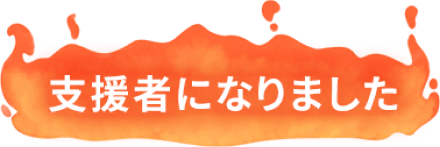English version is added.
Please use google translate for the rest of translation.
「喜如嘉の芭蕉布」を過去のものにしないために、芭蕉布の魅力と真の価値を伝える活動にご支援お願いします!
初めまして。沖縄伝統工芸染織クラブのメンバーです。
Hello, we are members of Okinawa Traditional Textile Club at Okinawa Institute of Science and Technology Graduate University (OIST) in Okinawa, Japan.
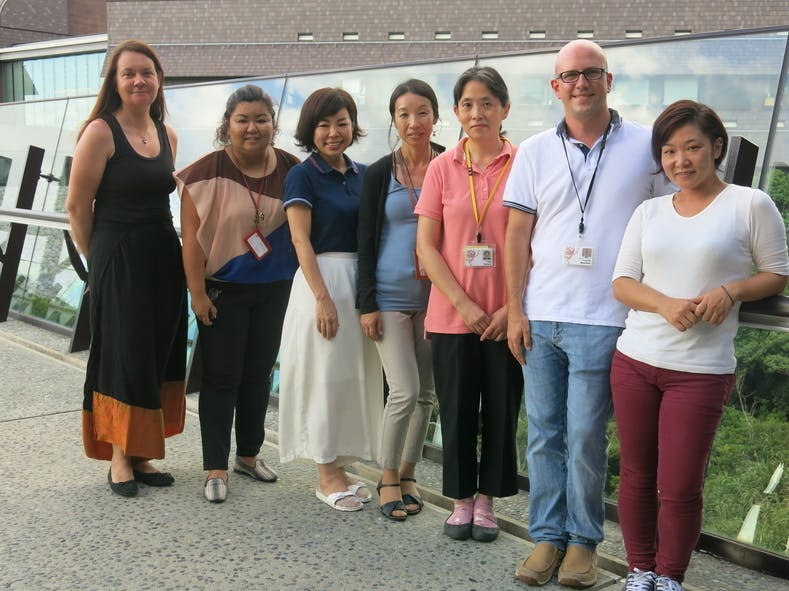
私たち沖縄伝統工芸染織クラブは、沖縄科学技術大学院大学の職員を中心に、沖縄にある伝統工芸染織の歴史、作品、技術、現状を学ぶ為に発足しました。特に芭蕉布は、沖縄を代表する伝統工芸である一方、衰退の一途をたどっていることから、今回の展示や講演会等を通して一般の方にも広く公開していきたいと思います。
Our club is established to provide opportunities for everyone including OIST employees, family memberes, as well as local residents to gather and talk about our common interests, Okinawa's traditional textile. One of the purpose of the club is to hold a study group for conserving Bashofu, which is heading for declining Okinawa's traditainally crafted and dyed fabric. Ideas from the study group are going to be shared with the public through exhibitions and lectures.
このプロジェクトでは、国指定の重要無形文化財である「喜如嘉(きじょか)の芭蕉布(ばしょうふ)」の真の価値を伝え、後世に残していくために、歴史・技術・科学の観点から、芭蕉布の魅力を紹介する展示会を開催します。そして、喜如嘉の芭蕉布を始め、伝統工芸の技術を絶やさないことの大切さと、その取り組みについて、最前線で活躍されている方々を招いたシンポジウムを開催し、芭蕉布や伝統技術に関心を持ってくれる人たちを増やしたいと考えています。
この展示会とシンポジウムを行うにあたり、写真、資料などの材料にかかる費用、パネルやポスターの制作や展示会で配布するためのリーフレットのデザイン・制作にかかる費用、そして、糸作り体験講師にお支払いする交通費が不足しています。芭蕉布の情報を正確にわかりやすく、そして一人でも多くの方たちへ届けるため、ご協力をお願いいたします。
Bashofu is a cloth made of the fibers of the Okinawan ito-basho, a tree looks like banana. And it is one of the National Important Intangible Cultural Property in Japan. In this project, we are going to introduce what Bashofu is and its history and unique techniques to make the cloth. Bashofu is one of
芭蕉布の着物は、王族が身につけ、貢物になるほど上質で高級な布でもありました。
数百年以上も前から沖縄で織られている布です。
芭蕉布は風通しが良く、肌に涼しく感じられるため、高温多湿の沖縄では、琉球王朝時代から、王族から農民にいたるまで、夏の衣類として重宝されていました。
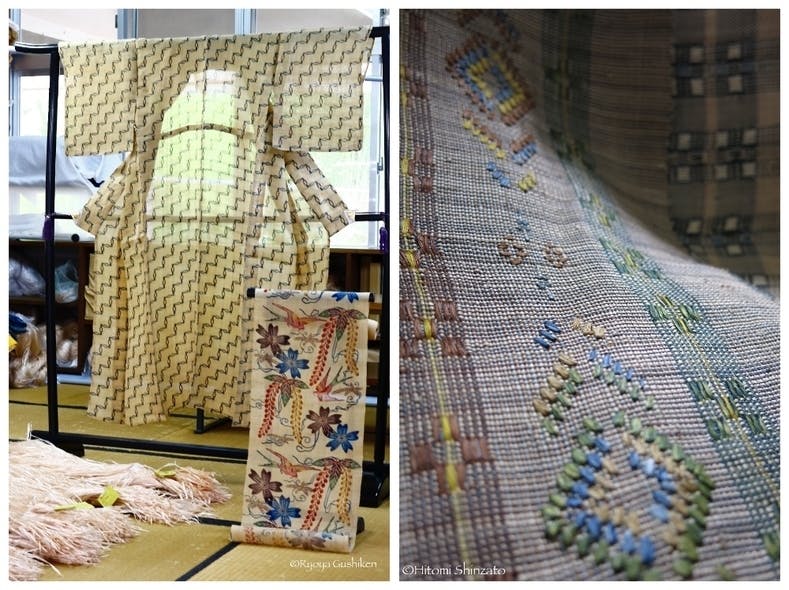
「芭蕉布って昔農民が着ていたやつでしょ、今高いよね。」
沖縄では、芭蕉布は祖父母のタンスから出てきたり、琉球舞踊で漁夫の衣装としても着られていたりすることから、 農民が着ていた野良着のイメージが定着していますが、実は、いくつものグレードがあります。
平民が家で織って着ていた芭蕉布は、肌触りが硬く、染色されていないものが主流です。柄も、無地か縞、格子、絣が入ったものが多く知られています。当時、平民は普段着として着る芭蕉布に、おしゃれな色や柄を入れるような余裕はありませんでした。
一方、官服として着られていた芭蕉布は、紺色や、青、緑色に染められていました。さらに、王族が着ていた芭蕉布は、平民が着ることが許されていなかった、ロイヤルカラーの赤や黄色に染められています。また芭蕉布は、琉球王府により本土の幕府や大名、外国への献上品としても珍重されていました。こうした上質の芭蕉布は、専門の職人により織られていたため、この技術が平民に伝わることはありませんでした。
また、沖縄の伝統芸能「組踊」の地謡奏者の正装として用いられている黒朝(くるちょう)は、以前は黒く染められた芭蕉布でしたが、芭蕉布を黒く染めるためには非常な手間や技術が必要となるため、現在では他の素材が用いられています。
戦前、芭蕉布は沖縄県内各地で織られていましたが、今では沖縄県北部にある、大宜味村(おおぎみそん)の一地区である喜如嘉が主な産地となっています。戦時中に一度は失われかけた芭蕉布でしたが、当時日本本土に疎開していた平良敏子さん(97歳)が、戦後、喜如嘉での芭蕉布作りを復活させ、さらに琉球王朝時代に王族が着ていたレベルまで、技術と芸術性を高めてきました。平良敏子さんは2000年に人間国宝に認定されています。
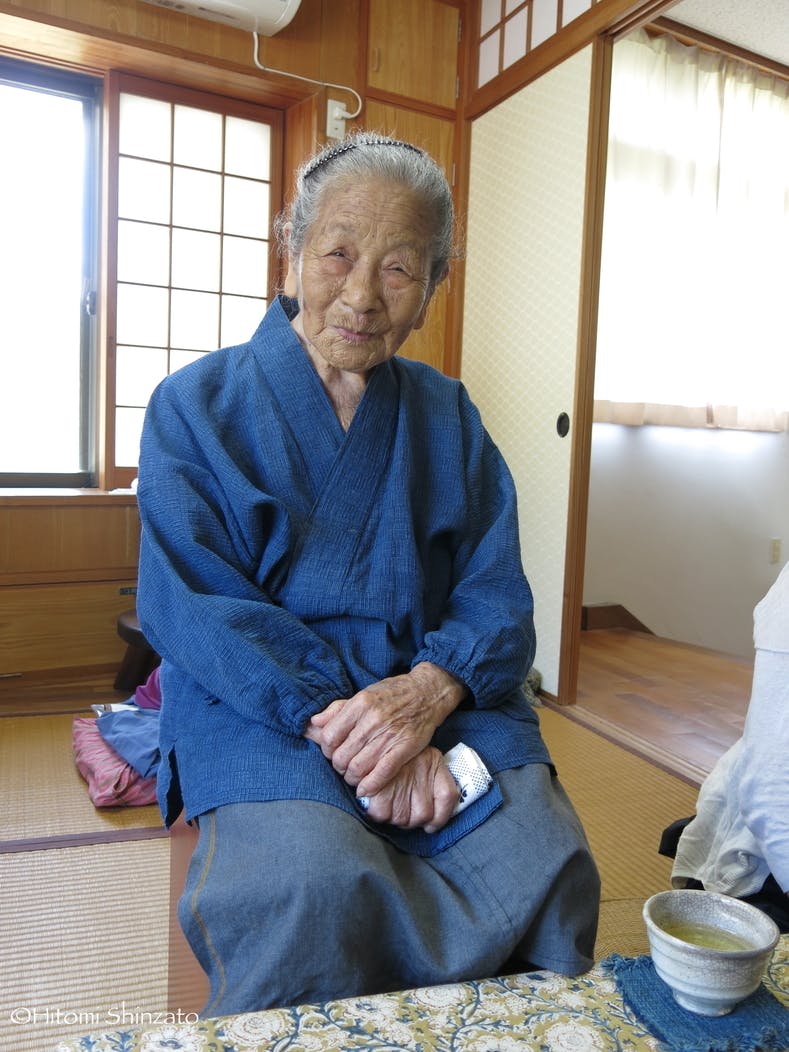
平良敏子さんは、芭蕉布を織る技術の難しさを、若いころを振り返り「とにかく、織りにくい。糸をしょっちゅう切らしてね。切れるたびに(切れた)糸を外して、また通してやってました。直してはまた切れる。それくらいもろい。。。」と語っています。
Grade of Bashofu
Although general images of Bashofu now may be a costume of fisherman in Ryukyuan Dance or farmers’ work clothes in the past, there were various grades in the quality of Bashofu textiles.
Most Bashofu textiles that were woven by commoners for their own use were not dyed and the textures were hard. The common patterns of their Bashofu textiles were plain, striped, checkered and kasuri. At that time, commoners could not afford to have their Bashofu Kimono, which were their everyday clothes, dyed colorfully or woven in fashionable patterns.
On the other hand, Bashofu Kimono which were worn by courtiers as official uniforms were dyed dark blue, blue or green. Bashofu Kimono worn by the royalty were dyed with red or yellow, the royal color, which were prohibited for commoners to use.
Bashofu textiles were highly valued as a tribute from the Ryukyu Kingdom to the Bakufu*, and Daimyo* in Japan or to foreign countries. These high-quality Bashofu textiles used as tributes were woven by professional craftsmen, therefore the technique had never been handed down to commoners.
Kuruchou is a formal attire for the backing chorus of Okinawan traditional performing arts called Kumiodori. Kuruchou used to be made of black dyed Bashofu textiles. To dye Bashofu black takes a lot of time and care with special skills, therefore nowadays Kuruchou are made of different materials.
Before the war, Bashofu were woven all across Okinawa, however, their main production area today is only Kijoka, an area in Ogimi village located in the northern part of the main island of Okinawa.
Bashofu was once almost lost during the WWII, until Toshiko Taira, 97 years old, who had evacuated to mainland Japan, revived the production of Bashofu in Kijoka after the war. She has not only revived Bashofu but also advanced the techniques and artistic quality to the same level as the Bashofu textiles woven for the royal family during the Ryukyu Kingdom Era. In 2000, Toshiko Taira was designated as a Living National Treasure.
*Bakufu- Japan’s feudal government headed by a Shogun
*Daimyo-Japanese feudal lord
芭蕉布の材料となる糸は、お金では買えません。
芭蕉布がどのように作られているか、知っていますか?芭蕉布を作る工程は、昔も今も全く変わりません。
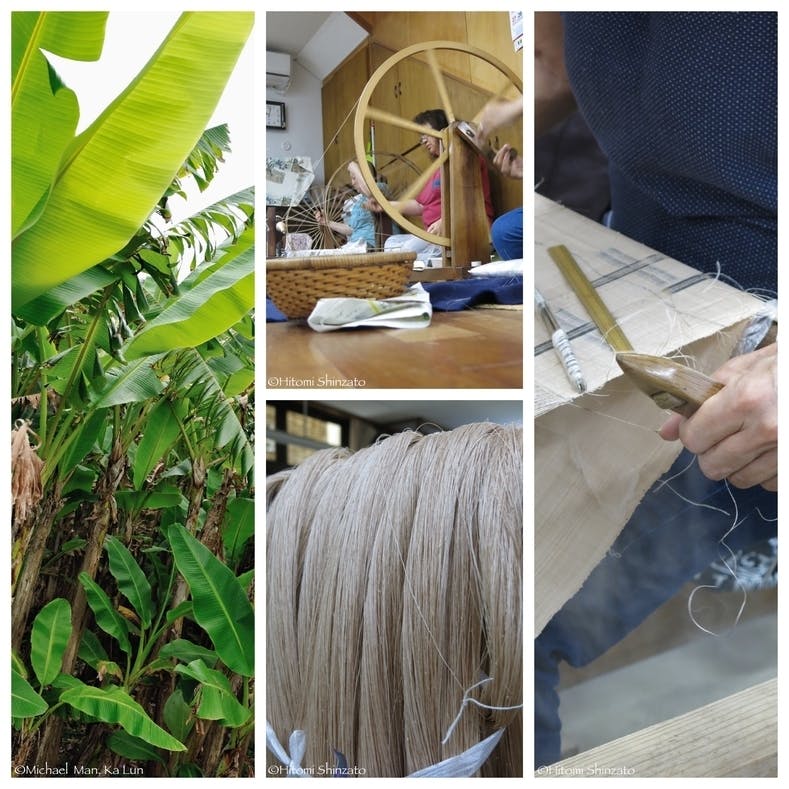
芭蕉布は、織り手の方々が、糸芭蕉(バナナの一種)の木の栽培から糸づくり、染、織までの全工程を自分たちで行っています。芭蕉布の材料となる糸芭蕉を、苗から3年ほどかけて育て上げ、特注のカマで切り倒し、手作業で何層もの皮を剥がし、灰汁で煮て、繊維を取り出します。1本の糸芭蕉から取れる繊維は僅か数グラム、一着の着物を織るために必要な糸芭蕉の木は、およそ200本にもなります。この繊維から、糸を績み、撚りをかけ、染色して織り始めるのですが、そこに至るまでに非常に長い道のりがあるのです。
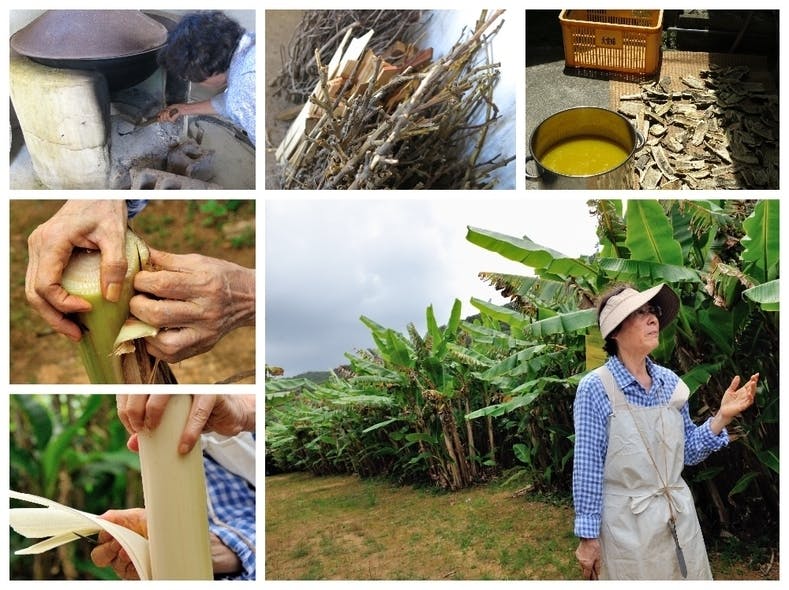
To get bashofu thread, plant ito-basho.
Making bashofu starts from planting ito-basho and it takes about three years for the tree to grow. Then craftsmen cultivate, strips layers of the stalks, and boil with wood lye to extract fibers. One ito-basho tree can produce few grams of fiber and to make a cloth big enough to make one Kimono, they need about 200 ito-basho.
芭蕉布作りにおいて「織り」は工程の1%
芭蕉布を作る作業は、全23工程にもわたります。機械どころか、木灰が必要なため薪を使い、ガスさえ使われることはなく、全て昔のまま、自然の材料だけを使い、全行程が人の手によって行われています。
喜如嘉芭蕉布事業協同組合の理事長で、平良敏子さんの義娘である平良美恵子さんはこう言います。「こんなに大変な思いをして作るのに、「えー、こんなに高いの?」「なんでこんなに高くなっちゃったの?」って言われるんです。上質な芭蕉布はもともと高価なものだったのに。」
Weaving is 1% of entire process of making bashofu.
In total, there are 23 steps to make a bashofu cloth and there is no powered machine involved in the process. And the way they make bashofu is the same way their mother, grandmother, and ancestors were making. Mieko Taira, a president of the association for the preservation of Kijoka Bashofu said,"we are working so hard to make bashofu (in the same way Okinawan's ancestors did) but people say, "That is so expensive!" or "How did it become so expensive!"... High-quality Bashofu is very expensive then too...
We want people in Okinawa, Japan, and the world to know the history of the bashofu and understand its true value.
芭蕉布の魅力とその歴史を知ってもらいたい。
芭蕉布の歴史や、製造工程を多くの人に知ってもらうことで、その価値や魅力をわかってもらいたいという思いで、展示会とシンポジウムを開催することになりました。
展示会では、沖縄や日本本土の博物館でもお目にかかれない、海外に渡ってしまった極上の芭蕉布の写真や、芭蕉布の歴史、作業工程の詳細、糸芭蕉(実物)などがパネルや動画を使って紹介されます。また、注目は、喜如嘉の芭蕉布を最新の科学で分析し、芭蕉布の機能性をわかりやすく解説した展示です。この科学研究は、今回この芭蕉布展を行うきっかけとなったものです。
この研究を主導した沖縄科学技術大学院大学(OIST)の野村陽子博士は「今どきこんな面白い布はないのです。」と言います。それは、ちょうど80年前の、民芸運動を始めた思想家の柳宗悦の言葉に呼応するものです。芭蕉布は、柳に、「今どきこんな美しい布はないのです。」(『芭蕉布物語』昭和17年)と言わしめた布なのです。
展示会最終日の9月22日(土)に行われるシンポジウムでは、糸芭蕉の生産現場が直面している問題とそれに対する挑戦についての話や、全国の古代布の現状などの話も聞けるまたとない機会となっています。
同日には、芭蕉糸作り体験や、分析に使用された電子顕微鏡の見学ツアーなども行われます。歴史、技術、科学という3つの異なる観点から芭蕉の魅力を余すところなくお伝えします。
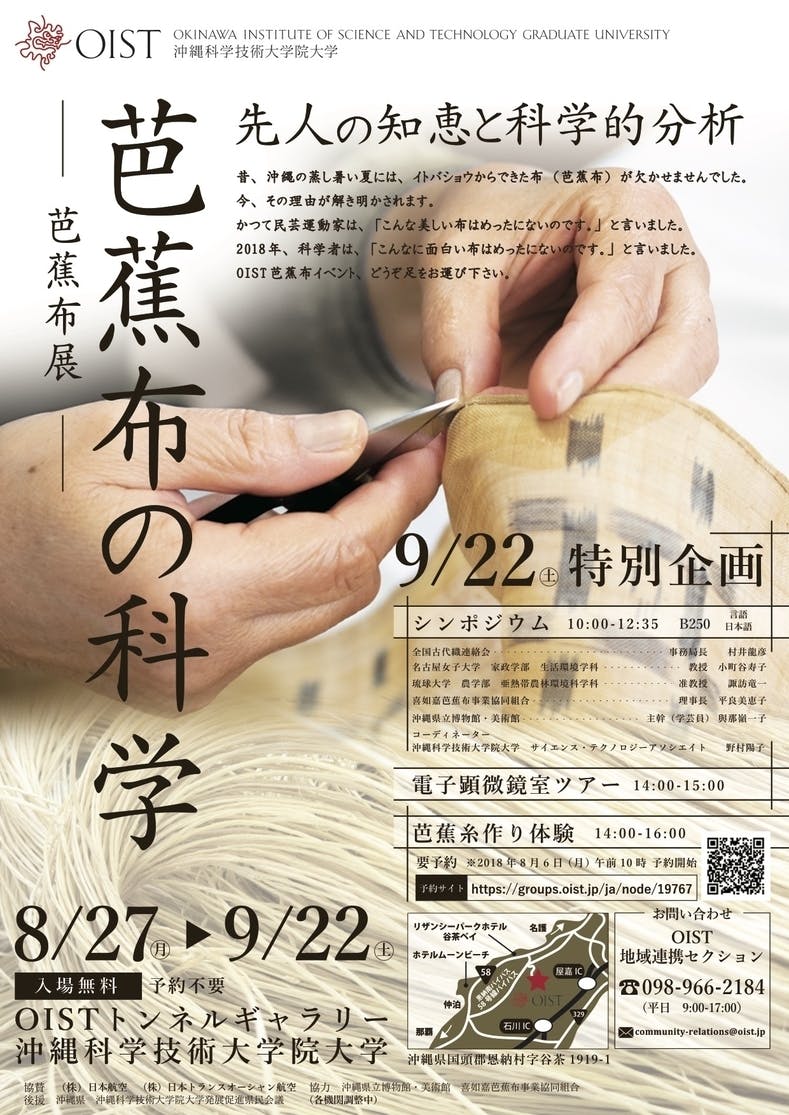
支援金の用途
- 展示会のリーフレット作成費:60%
- 展示会用ポスターの写真購入費:5%
- 展示会用パネル作成費:10%
- 糸づくり体験講師の交通費:5%
- 「喜如嘉の芭蕉布」保存会から「お返し」の購入:15%
- 「お返し」の送料:5%
今後のスケジュール
6月29日(金):展示会・シンポジウムの宣伝開始
7月2日(月):パネル・ポスター用写真、資料集め開始
7月17日(火):展示用パネル・ポスター作成開始
8月27日 (月)- 9月22日(土):芭蕉布展示会開催
9月22日(土):シンポジウム開催
問い合わせ先
沖縄伝統染織クラブ
TEL 098 982 3373
okinawa.dento.orimono@gmail.com

